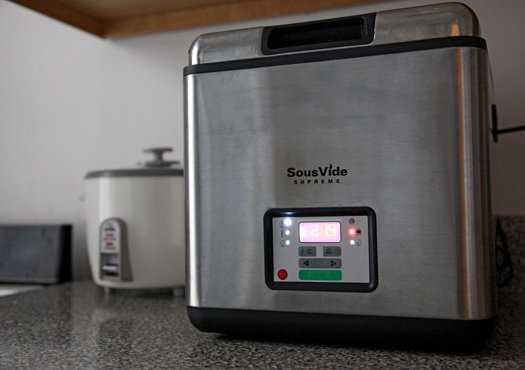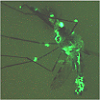A new machine aims to bring sous vide cooking to the home chef for the first time

Cooking sous vide is easy: seal the food in a bag, stick it in a water bath held at the precise temperature of perfection, wait, then enjoy meats and vegetables of such exquisite tenderness you may be surprised to find you’re eating plain-old Earthly beef, and not a never-before-savored endangered species.
The technique also represents the most literal transformation of your kitchen into the science lab it’s always secretly wished it was, with a $1,000 immersion circulator straight from your chemistry professor’s supply catalog being the tool of choice for restaurant chefs. There’s a lot to love for someone who enjoys both cooking and science immensely.
I am fairly confident in the kitchen, but the great thing about sous vide is that the me of 10 years ago, in college making Lipton instant noodles and ramen for just about every meal, could probably have summoned equally mind-blowing results from the Sous Vide Supreme. This is, again, a product of the technique’s almost Puritanical simplicity. All you need is a plastic bag and a water bath held at a consistent, unchanging temperature of your choosing. That’s it.
So what’s all the fuss about then? Well, let’s use a beautiful piece of hanger steak as an example. You could sear that steak in a cast iron pan over high heat, then stick it in the oven to finish for a few more minutes, let it rest and, if you know your oven and have done this a few times, come out with a perfect medium rare piece of meat to enjoy. Medium rare in the middle that is?the outer layer, no matter how perfect your timing and technique, will be overdone compared to the center.
Now let’s take that same piece of hanger steak and cook it sous vide. Salt and pepper it and seal it in a Ziploc bag (vacuum sealers work great for sous vide, which is, after all, French for under vacuum but they’re not mandatory?as long as the bag doesn’t float, you’re good). Then toss it in your 55-degree Celsius water bath. If you’ve read your McGee, you know that cooking adheres strictly to the rules of science: muscle cells, fat cells, collagen and connective tissues all break down and tenderize at consistent and exact temperatures. As a result, we know that 55 degrees Celsius (no Fahrenheit! this is Science!) is the temperature of perfectly cooked medium rare beef. So toss it in, wait 45 minutes?or 4 hours, if that’s more convenient, as the meat won’t rise above 55 degrees?then pull it out. It may look gray and gross right now, but do not fear! We know that the entire piece of meat has cooked in nothing but its own delicious juices to the scientifically derived temperature of perfect medium rare beef. The antidote to the yucky grayness is a good hot sear afterwards: fire up your cast iron pan to a scary level of heat and blast it for just a minute on each side with a little butter or oil in the pan to add a tasty, crunchy crust. Or if you really want to please your inner mad scientist, use a blowtorch. Then eat the most insanely tender and perfectly cooked steak of your life.
And while proteins lend themselves beautifully to sous vide cooking, fruits and vegetables are similarly revelatory, with luxuriously even textures that still maintain essential, basic raw flavor. Delicious.
Because the technique is inherently so simple, a review of the Sous Vide Supreme is more a review of sous vide cooking in general, because the machine only has to do one easy job. And based on my experience, it does that job just fine.
Underneath the basin sits a PID heating element, one that delivers periodic heat of varying intensity, unlike the basic “on” or “off” of a thermostat. Having the heat element only on the bottom worried me, because the only way to screw up a sous vide water bath is with unevenly distributed heat. But the first thing I cooked?eggs?seemed to dispel this potential weakness. Placing them right on the removable porous metal grate that separates the bottom of the basin from the rest of the tank (cooked for 55 minutes at 63 degrees), the eggs came out evenly cooked. And a sous vide egg is pretty magical?unlike a poached egg, the yolk is actually thicker than the whites, retaining a custardy or pudding-like texture. Delicious in a bowl of noodle soup, cracked over some asparagus, or on toast.
With this initial worry out of the way, I proceeded to throw just about everything I could into the machine. Sirloin steaks, pork loin, shell steaks, Arctic char, fennel, apples, pork belly, short ribs, lamb shanks?all were delicious and in some way transformed from conventional cooking. For pornographic photos of every food I cooked sous vide (and a guide to times and temperatures and my thoughts on cooking each dish), see the gallery here.
The beautiful thing is that the cooking is exceedingly easy: to cook something sous vide, all you really need to know is what temperature and how long. Sous vide has a reputation for being incredibly time-intensive, but tender cuts of meat and most vegetables and fruits can be cooked through in an hour or less. Fish can cook even more briefly, depending on the portion size. Only tougher cuts of meat that one would normally braise (like short ribs or lamb shanks) require the long haul?I kept my short ribs in for 48 hours, for example.
Knowing those two variables, you can cook anything sous vide. But the Internet?normally a bountiful font of foodie information?is currently pretty light on practical sous vide info. Which is due, of course, to the technique still being used only by professionals. But thankfully, one of sous vide cooking’s all-stars and one of America’s most lauded chefs, Thomas Keller, has written Under Pressure, an abundantly useful book. Even if you call your pork belly “pork belly” and not “breast of pork” and skip the two or three complex purees that accompany each wildly technical recipe, the book is an excellent guide for times and temperatures of over 100 ingredient preparations, ranging from veal kidneys and duck gizzards to eggs, apples and sirloin of beef. It’s $75, but it’s the only definitive guide to sous vide cooking available in English right now.
Other invaluable references are Harold McGee’s aforementioned On Food and Cooking, which is the Bible of the science and history of food and really a must for anyone with an interest in cooking or even just eating. And available online is University of Colorado mathematics Ph. D. candidate Douglas Baldwin’s detailed sous vide guide, derived clearly from much experimentation.
I’ve enjoyed cooking with the Sous Vide Supreme immensely?anyone who loves food and cooking is always delighted by new tastes and textures, and the cooking sous vide is a constant source of both. But at $450 (available from the company’s Web site and in most Sur La Table stores) , it’s probably too expensive for all but the most serious home cooks. Less than half the price of a PolyScience immersion circulator, yes, but still priced beyond those who just want to experiment.
But if you’re looking for an easy all-in-one sous vide setup and can stand the price, the Sous Vide Supreme gets the job done, deliciously.
Also check our good friend Wilson’s review over at Gizmodo for his thoughts, and even more delectable food-based pornography
Popular Science has been a leading source of science, technology and gadget news since 1872. With up-to-the minute latest space news, insightful commentary on the new innovations and concept cars ...if it's new or future technology you'll find it at popsci.com.au.
WW Media - Popular Science © 2010
Cameras - Home Entertainment - Mobile Phones






Enjoyed reading this article. Price is relatively cheaper than anything else on the market. The idea is to use this wonderful appliance on a day-to-day basis and just for occasional experimentation. Once you get used to the concept, the nutritional benefits and the exceptional results sous vide cooking technique can produce, it will be difficult to go back to your old ways.